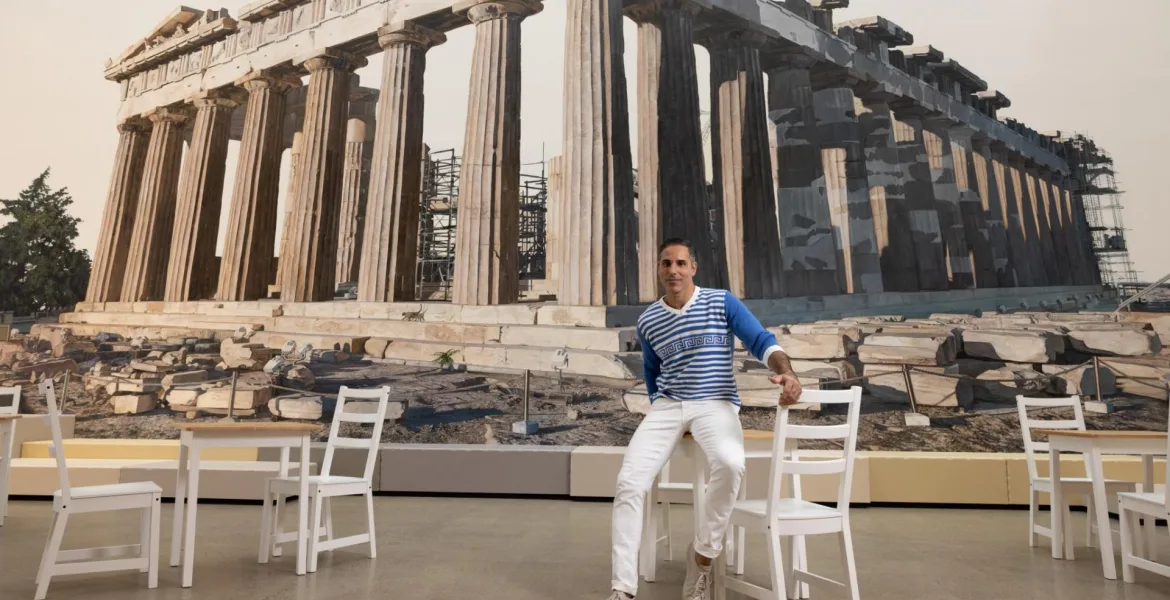An eclectic art exhibition has just been unveiled at the Queensland Gallery of Modern Art (GOMA) in South Bank, Brisbane. The Favourite by Michael Zavros, a Greek-Australian artist, incorporates more than 100 works, mostly hyper-realistic paintings but also sculpture, video, photography and performance, representing 25 years of creative artistic output by one of Australia’s leading contemporary artists and culminating in the installation of a stunning, life-like Parthenon mural.
Michael Zavros is predominantly a hyper-realist painter who has been described as an aesthete who paints beautiful things beautifully, be they still life, portraiture or landscape. His works, marked by sumptuous realist renderings and surreal juxtapositions, have been exhibited in major museums and galleries throughout Australia, New Zealand, Asia and Europe.
In this show, the viewer is offered a survey of the artist’s creative explorations, including fashion magazines, European palaces, luxury cars, his children, Narcissus and still life, in addition to his self-portraits and reflections upon his heritage.
The retrospective also coincides with another exhibition ‘Beautiful Wickedness’ by the artist known as eX de Medici, and both proved to be instant successes on opening night in front of a packed gallery.

The Director of the Queensland Art Gallery /Gallery of Modern Art, Chris Saines, CNZM, opened the proceedings by noting that The Favourite literally begins at the footsteps beneath the monumental colonnade of the Parthenon, a forlorn and ruined witness to its looting, to unveil Michael Zavros’ love for the classical ideal and beauty and craftsmanship.
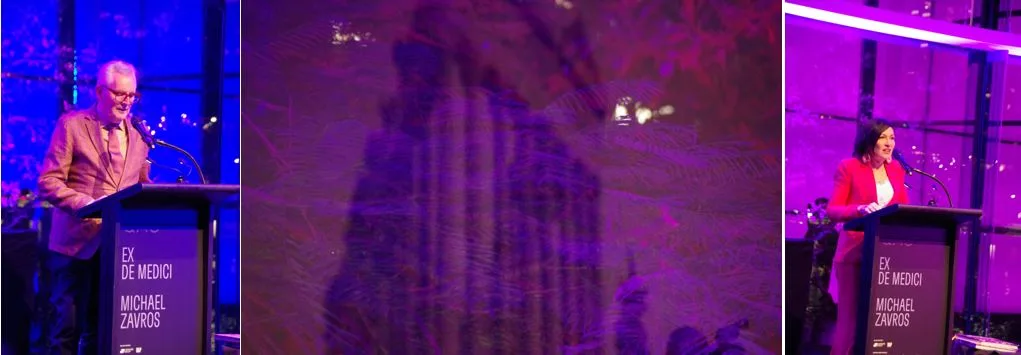
Saines remarked that Zavros’ works, more than the culmination of their deftly blended and impeccable brushstrokes, “stylise and reframe rather than imitate reality”. According to the Gallery director, Zavros is a “very knowing painter” whose signature photorealistic work embodies precision and layers of metaphor :
“At the core of the exhibition and among the things that differentiate Michael Zavros from other artists of his generation is an unapologetic love of beauty and craftsmanship, folly, and grandeur. Audiences will enter Michael’s world. They will see the rigour and breadth of his practice and how his work across multiple media reveals a subtly evolving worldview. His work is inescapably about who he is: his lifestyle - real or imagined - his family, his interests and values.”
The Queensland Minister for the Arts, Leeanne Enoch MP, in officially opening the exhibition declared that The Favourite is an opportunity to celebrate the creative talent of Michael Zavros.
And indeed it is an art exhibition to savour.
The Greek
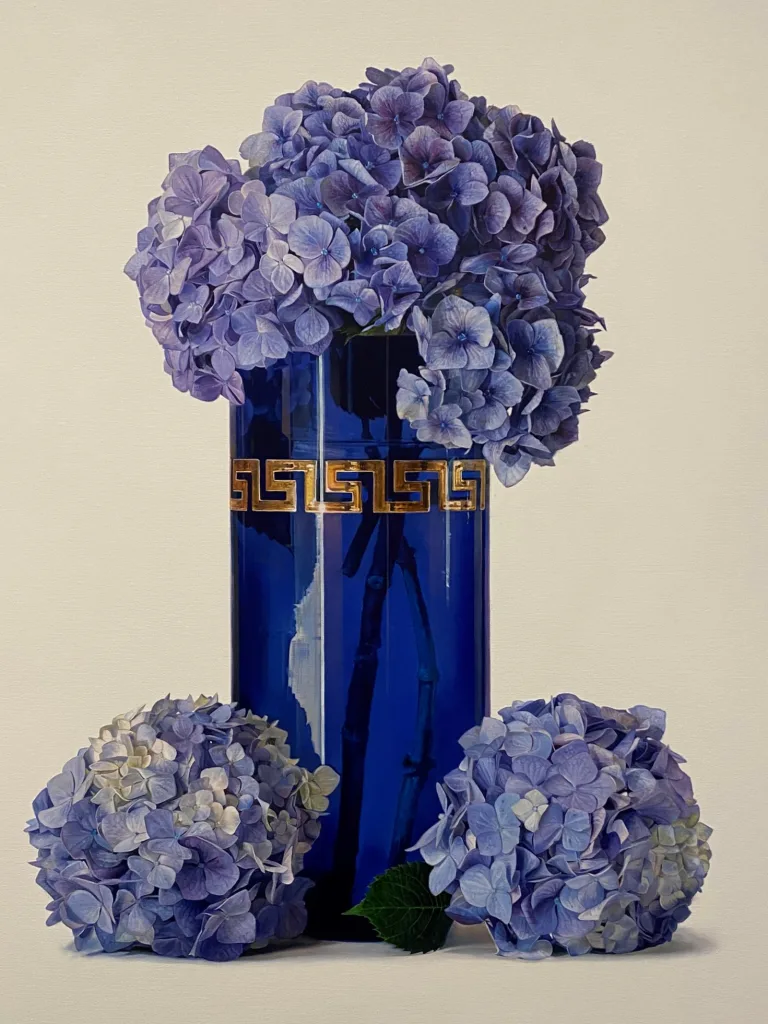
Michael Zavros' The Greek, as a still life photo-realistic rendering, has been described as a “rhapsody in blue” which features a distinctive Greek deep blue glass vase with decorative meander gold motif and a delicate bloom of blue hydrangeas.
It may also just be the celebration of the perfected Greek male in terms of its phallic composition.
Love's Temple
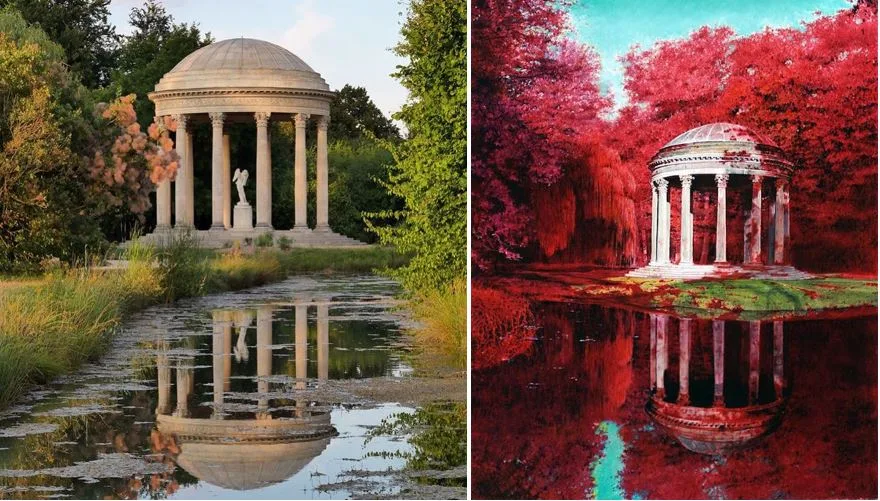
For Michael Zavros, Love's Temple (2006) is one of his favourite miniature paintings based on Marie Antoinette's commissioned building at Versailles, the neo-classical Love Monument completed in 1778, which, according to the artist, was perhaps the “ultimate folly”: a meditation on what might happen if one loves something too much, even if love is stronger than hate.
As Michael Zavros explains:
“I manipulated the colours to create a sort of creeping virus, as though the act of loving the temple had brought about its own corruption. Today, Versailles is at the mercy of millions of tourists who visit it annually, unwittingly bringing about its slow and steady degradation. By loving it too much they are killing it.”
At the British Museum
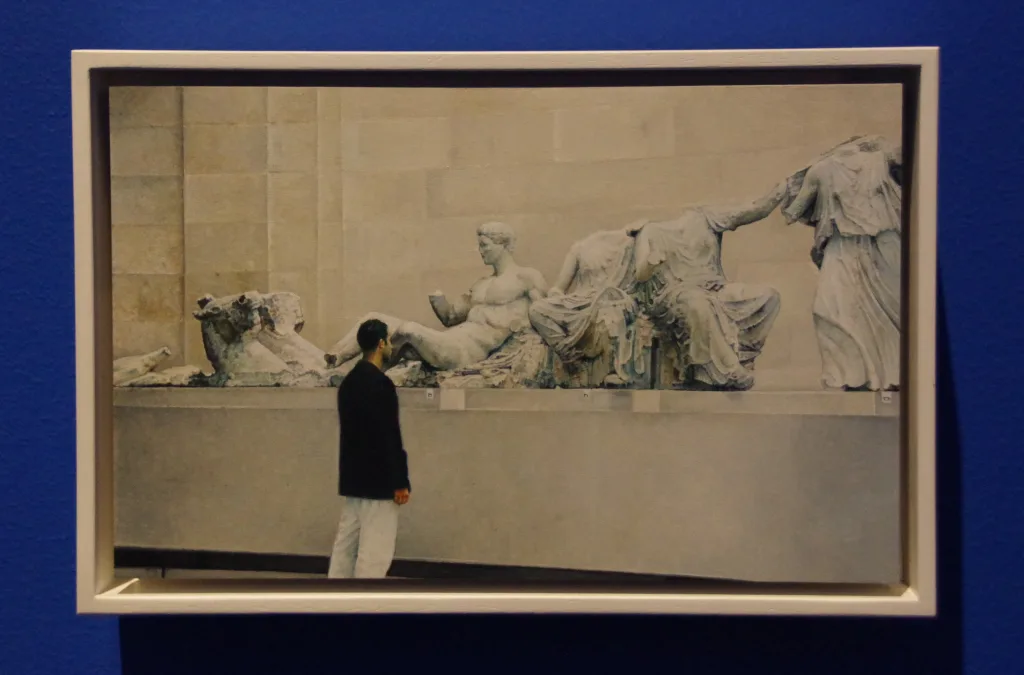
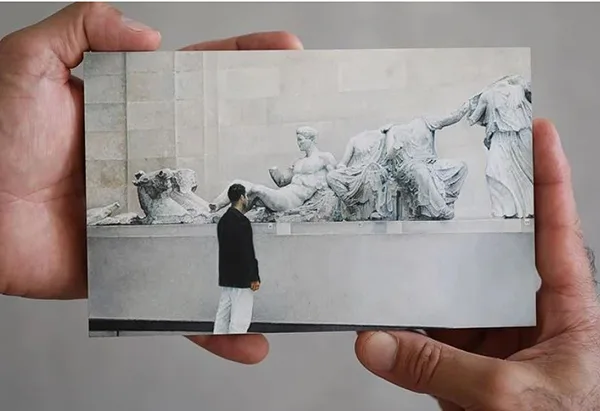
The Greek hyperrealist in the early stages of his career painted miniatures – little vignettes of immaculate detail. He returned to this genre with his entry in the 2022 Archibald Prize. At the British Museum, which is a meticulous self-portrait of the artist gazing upon the Elgin Marbles, now greets the visitor upon entry into The Favourite exhibition.
Michael Zavros' impeccably detailed painting was inspired by the artist’s first visit to the British Museum in 2001 and, in common with his other oil paintings, this work hides any evidence of the artist’s hand and is more akin to a photograph. According to Zavros:
“People often photograph themselves in front of grand monuments, staking a claim on history and their moment with it. But this tiny painting represents a fleeting, humble and troubled moment before the great marbles of the Parthenon. I was away from home and so were they.”
The Centaur (Palomino)
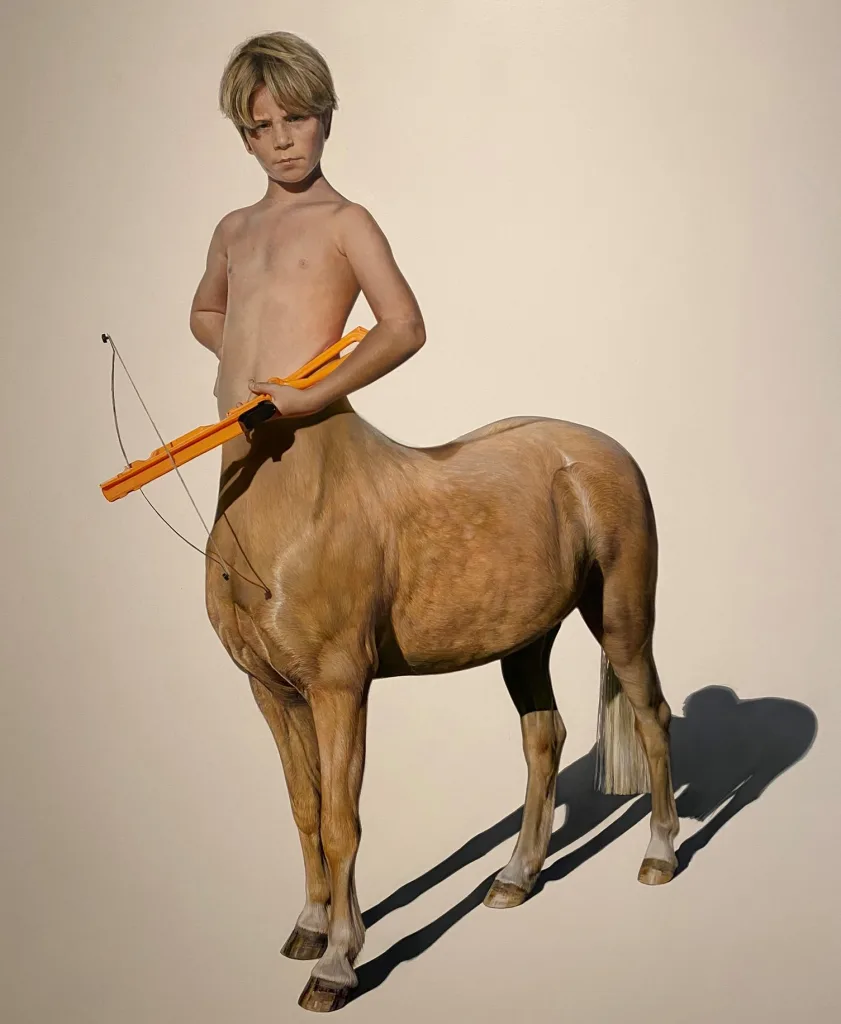
Hyperreal images of horses and centaurs are part of Michael Zavros’ extraordinary body of work.
An example is his ‘post-human’ centaur hybrids. In this 2021 work titled Palomino, Michael’s young son Leo (Leonidas), appears as a centaur staring at the viewer, armed with Cupid’s bow. As a Greek-Australian, Zavros has always been interested in the mythical half horse – half human figure of the centaur, both as an image of superlative beauty and as a technical challenge.
Narcissus
Michael Zavros is particularly fascinated with the classical ideals in ancient Greek history and mythology and these are captured in his meticulous photorealistic works rendered in exacting detail.

One such image is inspired by Narcissus, a handsome youth who falls in love with his own reflection in a still pool of water - as symbolically portrayed in the famous late 16th century painting by the Italian Baroque master of radical naturalism, Caravaggio.
Narcissus is caught in an inescapable misery of falling in love with the unattainable until he dies. In his history painting V12 Narcissus (2009) Michael Zavros embraces the narcissist theme as the artist looks intently into the highly polished bonnet of a luxury car (actually the artist's beloved Mercedes), embracing the body with his hands as he is eternally drawn to his own reflection.
Bad Dad
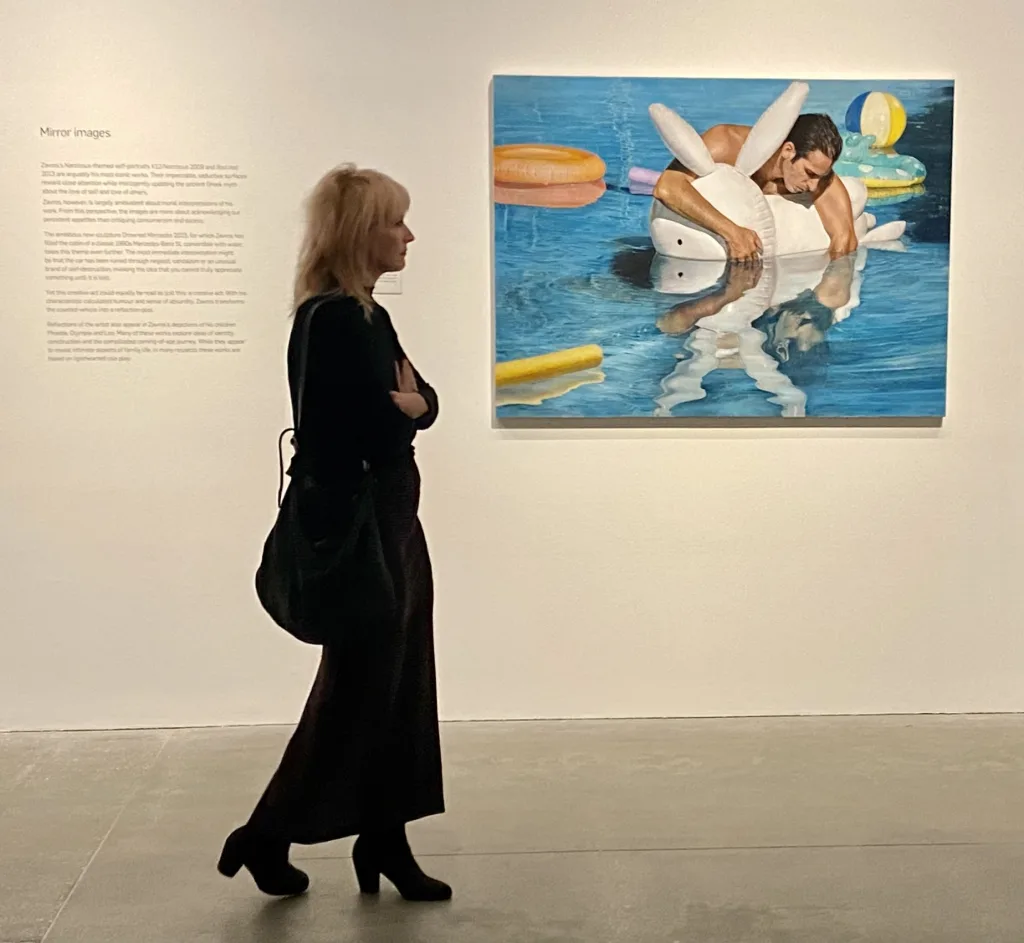
This theme is pursued in a later work, Bad Dad, which was entered into the 2013 Archibald Prize. Here, we see Zavros’ self-absorbed narcissist, drifting alone in a swimming pool with colour-saturated inflatable toys (as homage to one of his favourite artists, Jeff Koons) whilst enjoying his own reflection.
According to Zavros:
“In the painting I have cast myself in the role of Narcissus in a contemporary evocation of the ancient Greek myth, and as something of a cautionary tale … locked in a circle, his reflection enveloped by a creeping darkness … the doomed anti-hero doesn’t spurn the affections of a lover for his own reflection. Rather he rejects paternal care and the trials of domesticity.”
Discobolous with a Z 2021
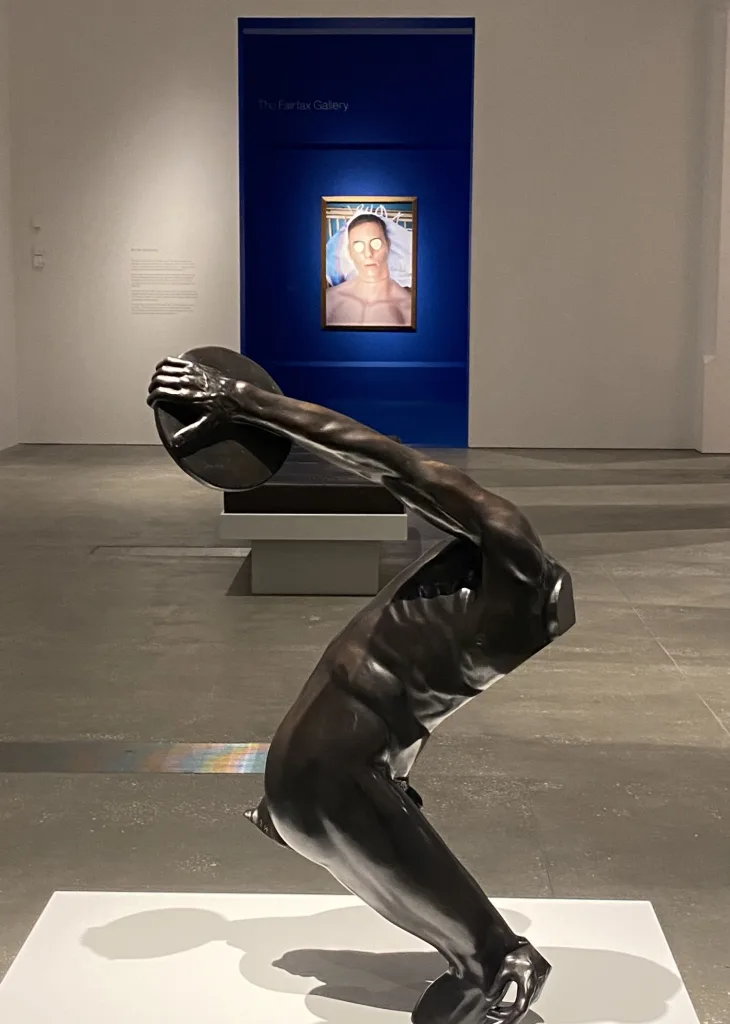
Zavros’ tribute to the Greco-Roman sculpture Discobolus by Myron is a bronze sculpture which the artist completed in collaboration with a local foundry and fellow artist Philiip Piperides.
Drowned Mercedes
 Michael Zavros with Drowned Mercedes 2023 (Images: David Kelly)
Michael Zavros with Drowned Mercedes 2023 (Images: David Kelly)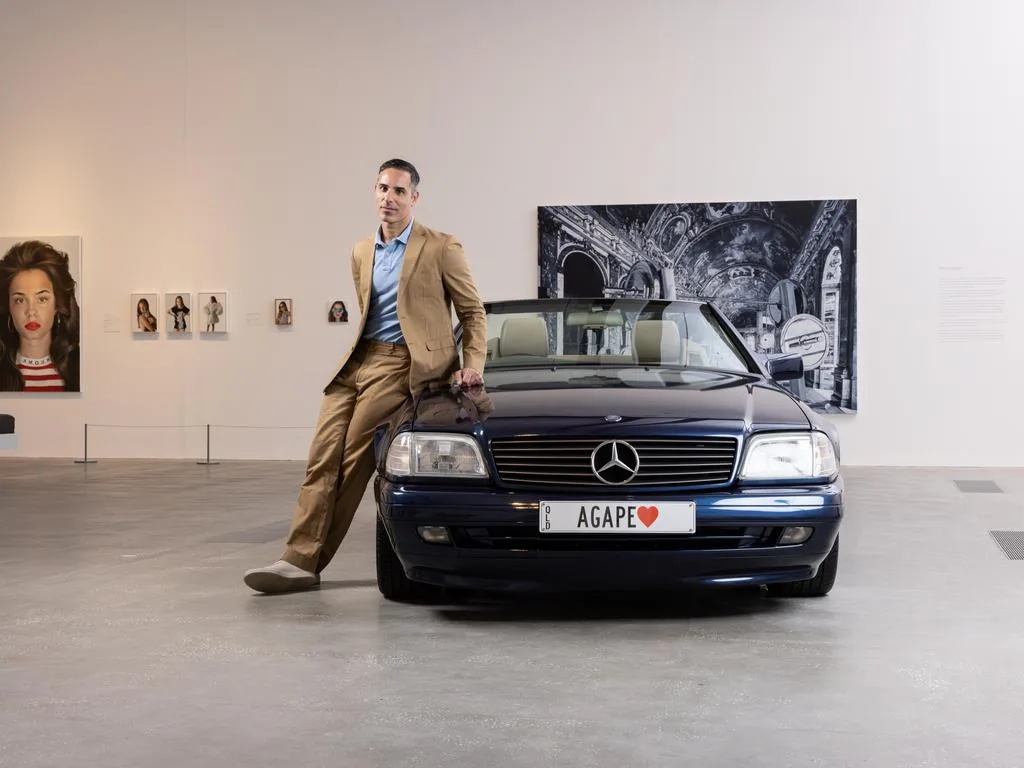
Drowned Mercedes (2023), a major sculptural work created for the exhibition, sees an original classic 1994 Mercedes-Benz SL600 convertible, with a number plate proclaiming agape (the Greek word for love) filled with water and inviting gallery visitors to view their own reflection.
The artist’s meticulously constructed images and works encapsulate themes of luxury, beauty and decadence in ways that are highly aestheticized and technically faultless and yet deeply contemplative and, at times, displaying a wry sense of humour.
Acropolis Now - Gazing upon the Parthenon
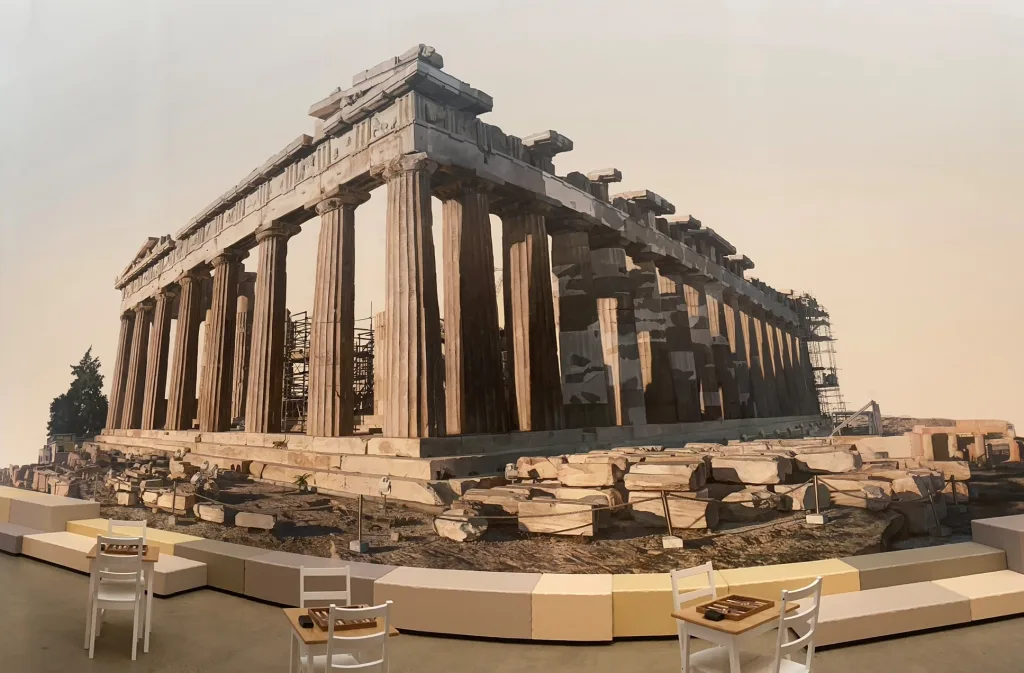
Michael Zavros’ retrospective exhibition is also defined by the giant Parthenon mural. Measuring more than 7m in height and 19m long, this meticulously rendered wall painting dominates the central atrium as the visitor enters the gallery. According to Zavros:
“The Parthenon exists as an incredible ruin and it is made so much more beautiful in its ruined state”.

The mural was painstakingly painted by Zavros and his assistants over a number of months and, as the talented artist recounted, it was amusing to see people drop by every day to watch this magnificent temple come to life on the walls of the gallery, as if to reflect what ancient Athenians did 2,500 years ago as they gazed upon the Sacred Rock as the Periclean-inspired Parthenon rose from the ground.
It was in fact painted from photographs and other found imagery as Michael Zavros has not visited Athens since 2012.

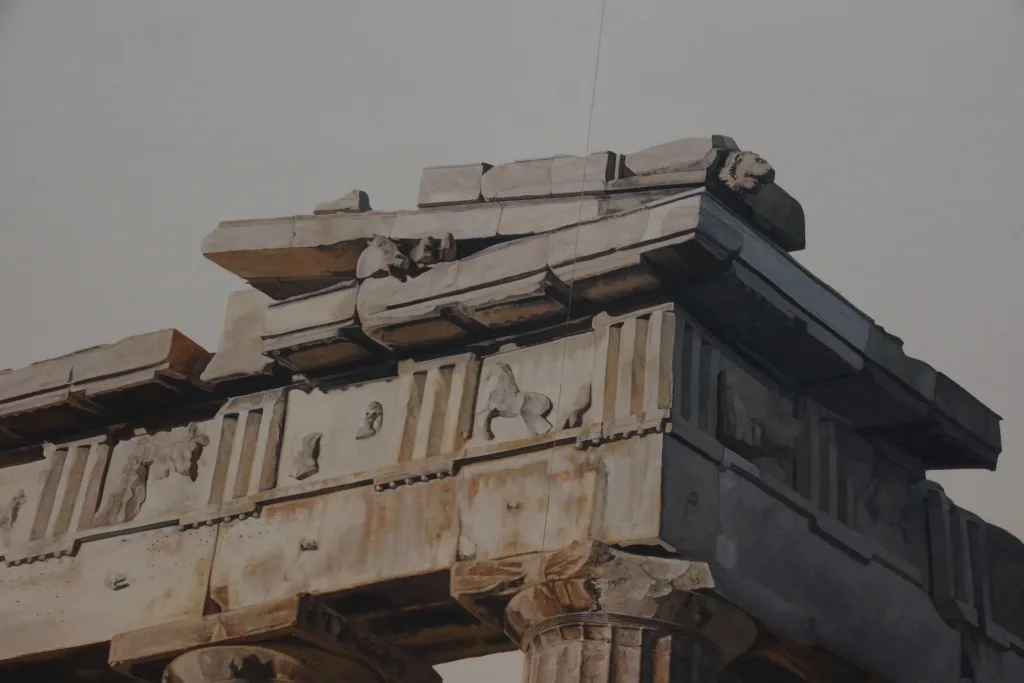
The giant hyperreal painting speaks to us of Classical Greece. It is also a homage to the artist’s Greek heritage as well as his concern about the missing sculptures from the Parthenon that await their return to Athens. Whilst the monument of all monuments may have now been reproduced in Brisbane it is still half empty. For this artist, the issue of the historical dislocation and the desired reunification of the sculptures that were once integral to the aesthetic sensibility of the Parthenon can no longer be ignored:
“The Greek people - my people - invented so much of the mathematics, art and philosophy my kids are learning at school now. We were overachievers, until one day we weren’t, and this famous building on the hill of Athens reminds contemporary Greeks of what we once were. Now everybody’s claiming what’s theirs, and repatriation is part of that conversation. I’m thinking, how do I contribute to that? It’s something. At school they are encouraged to investigate who they are and where they come from. A lot of our conversations are about this.”
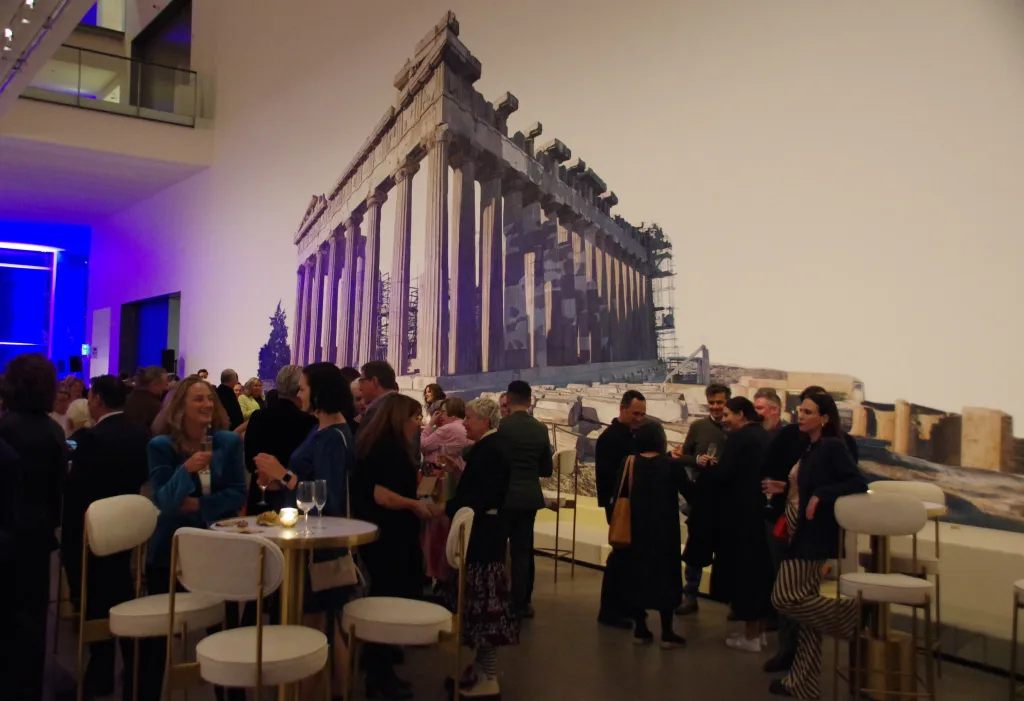
Acropolis Now features a pop-up Greek café replete with tables and backgammon (tavli) sets to encourage robust discussion and debate in the hallowed traditions of Classical Athenian democracy. It will literally function as a Greek coffee house or kafenio, inviting exhibition visitors to join in.
The Curator of the exhibition, Peter McKay, sees this work as a political gesture: an unfinished temple which is missing significant pieces. It is a subtle but strong acknowledgement of history, the complex identity of migrant community and a story of repatriation.
Instagram moment
The photorealistic artist connects with the cultural removal but also sees the work as an Instagram moment:
"I like the light, touristy gesture of creating this selfie moment underneath the Acropolis. When you go to the Acropolis you are aware of the weight of it.”
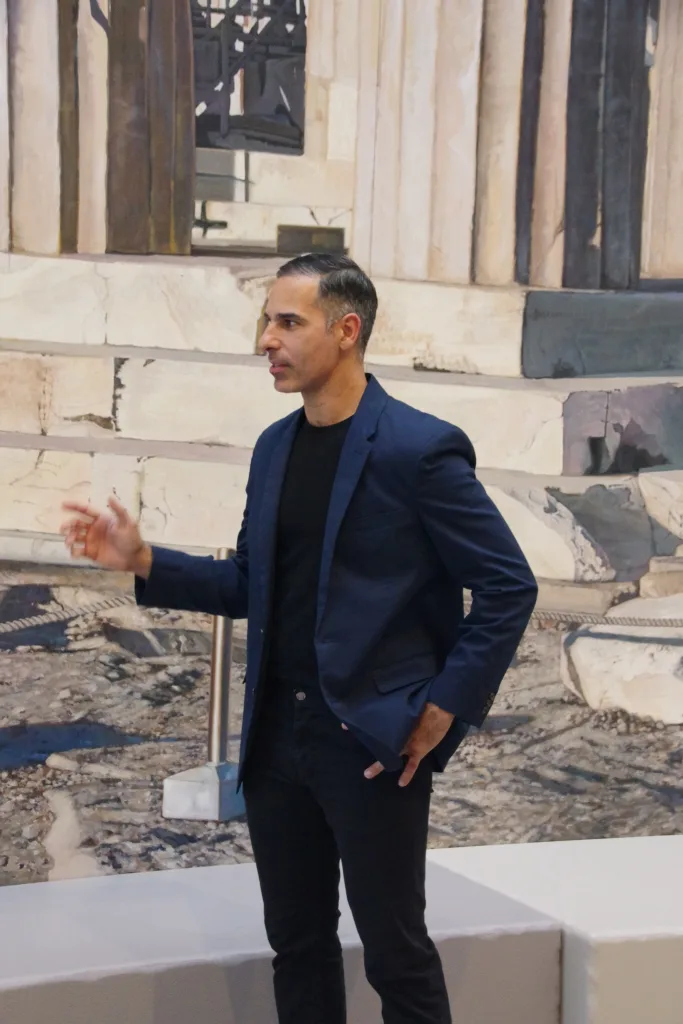
This writer could not resist that invitation and the resulting surreal selfie was greeted on social media with reactions bordering on disbelief that the photo was not actually taken in Athens.
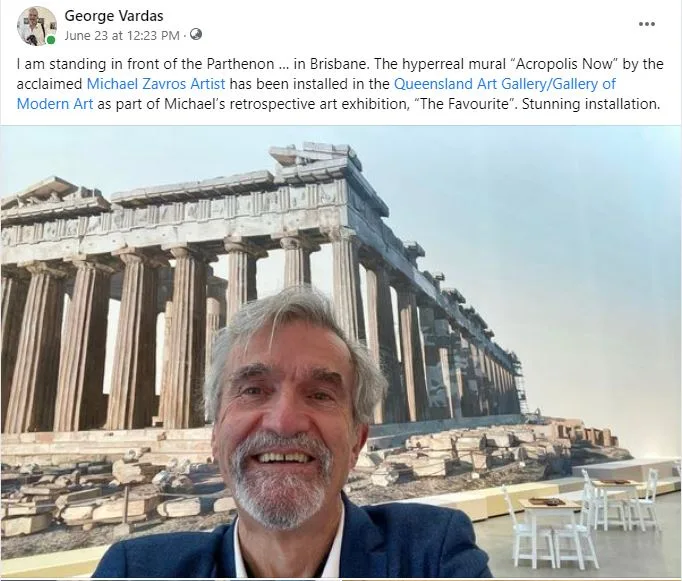
“Acropolis Forever”
At the end of the exhibition the 'transient' Acropolis Now mural will literally be painted over although Zavros believes that its transience or impermanence is part of its appeal.
Rather than being brushed over and erased from history, I suggested to Amelia Gundelach, the Media Manager of the Queensland Art Gallery/Gallery of Modern Art, that a more symbolic gesture might be to remove the artwork currently in situ (with a benevolent sponsor covering the costs of remediation of the gallery’s wall) and transporting the mural, piece by piece, to Bloomsbury. If the British Museum continues to refuse to return the Parthenon Sculptures to Athens then the Parthenon (or at least its sumptuous hyperreal rendering) can go to London to highlight the continuing disconnect between the Phidian forms trapped in the Duveen Gallery and the Acropolis in Athens.
A case, perhaps, of Acropolis Forever.
George Vardas is the Arts and Culture Editor and is also the co-Vice President of the Australian Parthenon Association. He will be joining Michael Zavros and Peter Mackay, the curator of the exhibition, at GOMA on Saturday 22 July 2023 for an interesting talk on the Parthenon Marbles and the return of looted cultural artefacts titled Raiding the British Museum
The Favourite is on exhibition at the Gallery of Modern Art (GOMA) in Brisbane from 24 June to 2 October 2023.

